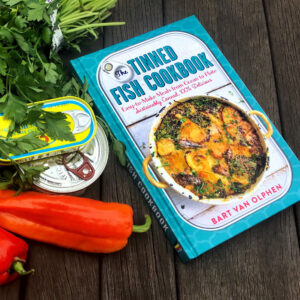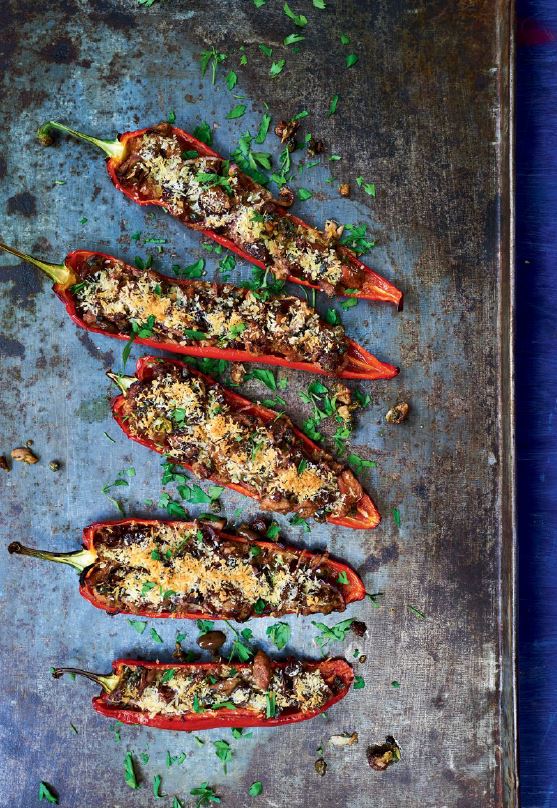 Tinned fish is having a moment right now, especially as so many of us are reaching into the back of the pantry to cook with what we have on hand. However, canned fish isn’t just a fallback food in between trips to the grocery store—according to Food & Wine, it’s a staple that “deserves center stage.” And that just happens to be the philosophy of Bart van Olphen, author of The Tinned Fish Cookbook, out now!
Tinned fish is having a moment right now, especially as so many of us are reaching into the back of the pantry to cook with what we have on hand. However, canned fish isn’t just a fallback food in between trips to the grocery store—according to Food & Wine, it’s a staple that “deserves center stage.” And that just happens to be the philosophy of Bart van Olphen, author of The Tinned Fish Cookbook, out now!
The Tinned Fish Cookbook offers up easy-to-make meals that elevate canned fish to “the heights of deliciousness” (The New York Times). Filled with unique (and scrumptious) recipes for canned tuna, salmon, anchovies, and more, seafood lovers and home chefs alike are sure to find a new favorite dish. What’s more, Bart dives into the wonders of modern fishing and canning, helping you recognize eco-friendly fish, so you can enjoy your ocean-to-plate meal with confidence.
So what are you waiting for? Read on for a sample recipe from the book (Bart’s colorful Tuna and Olive Stuffed Romano Peppers), and grab your copy of The Tinned Fish Cookbook, out now. And, as an added bonus, don’t miss Bart’s Instagram for simple how-to videos for recipes from the book!
***
 It was around fifteen years ago that I fell in love with tinned fish as I traveled through countries like Spain, Portugal, and France, where they really know and adore it. Aside from the lovely packaging of many of these tins—reason enough to buy them—the fish inside was surprisingly flavorsome, too. I remember visiting a small-scale conserverie, or cannery, in northern Brittany during those years. Just before I left, the owner, Marie Bevillon, handed me a gorgeous tin of sardines. “Don’t eat it right away!” she said. “Turn it over regularly and they’ll get even better, like a good bottle of wine.” And they did! I’ve been sold ever since.
It was around fifteen years ago that I fell in love with tinned fish as I traveled through countries like Spain, Portugal, and France, where they really know and adore it. Aside from the lovely packaging of many of these tins—reason enough to buy them—the fish inside was surprisingly flavorsome, too. I remember visiting a small-scale conserverie, or cannery, in northern Brittany during those years. Just before I left, the owner, Marie Bevillon, handed me a gorgeous tin of sardines. “Don’t eat it right away!” she said. “Turn it over regularly and they’ll get even better, like a good bottle of wine.” And they did! I’ve been sold ever since.
My passion for fish began in the mid-1990s. With the Michelin Guide and my catering school diploma under my arm, I boarded the train to Paris. Since early childhood it had been my big dream to work at a Michelin three-star restaurant. I was given my first taste of this at Lucas Carton, one of the top gourmet restaurants in Paris. I started off washing lettuce and peeling potatoes, but soon found myself preparing the starters and mains—including many different kinds of fish, all with their own unique flavor and texture. Here I learned that preparing fish is actually really simple, and that you can put a terrific fish course on the table in just a few steps.
My learning experience in France got me hooked on creating and preparing all kinds of fish dishes—fast-forward years later, and now I’m just as happy preparing a recipe with a tin as I am using a piece of fresh fish. That’s because tinned fish is surprisingly versatile in the kitchen. But it calls for preparation with a slightly different mind-set, since the fish has already been cooked inside the tin. It’s a question of combining flavors, adding a drop of acidity, a touch of color, and a bit of crunch. But the best thing about cooking with tinned fish is that it’s simple, quick, and absolutely delicious!
Unlike its fresh and frozen counterparts, the fish that goes into tins is almost all caught in the wild, and much of it is oily fish—many people’s favorite—which lends itself particularly well to canning. Tuna, salmon, sardines, anchovy, and mackerel in water or oil taste sensational. Often, the fish is caught in peak season, too, which is beneficial for both fish stocks and quality: It guarantees you’ll get the most succulent fish at an affordable price, thanks to the efficient production processes. Not to mention the tins usually have an unrefrigerated shelf life of over four years, so you never have to worry about it rotting in your fridge.
But not all tinned fish is created equal. I have traveled extensively to fish, cook, and live with the most amazing and responsible fishing communities all over the world, and I’ve learned it’s important to know where our fish comes from and how it was caught. More than 80 percent of the world’s oceans are currently fished to capacity or are overfished, so when you buy fish, make sure it’s from sustainable stocks. Thankfully, the labels on tins inform consumers whether the fish comes from a sustainable (certified) fishery. (As you’ll learn, MSC certification is best.) Transparency makes all the difference. That’s why this book doesn’t just contain scrumptious recipes, but also introduces you to the fishermen and women who ensure that you can continue to enjoy the tastiest fish with a clear conscience.
It has been my joy and privilege to compile over forty recipes using the various kinds of tinned fish available in stores so you can enjoy the best that they have to offer: recipes for a quick bite, snacks, appetizers, lunch, and dinner that incorporate a delightful range of tinned fish —from tuna to mackerel to herring and more. Many of them are easy, fast, affordable, and, above all, fun to make. And though the recipes serve two people, if you’re catering to a bigger household, note that you can simply multiply the ingredients to create your fishy feast.
I hope this book will inspire you to regularly use tinned fish in the kitchen—sustainably caught and exceedingly delicious, of course. Enjoy!
TUNA AND OLIVE STUFFED ROMANO PEPPERS
• SERVES 2 AS A STARTER •
Ingredients
- 1 small red onion, diced
- 1 small garlic clove, minced
- 12 shiitake mushrooms, chopped
- Half a 2-ounce (45 g) tin of anchovies, drained
- One 5-ounce (140 g) tin of tuna in olive oil, drained
- 2 teaspoons capers
- 5 black olives, halved
- 2 romano peppers, halved
- 2 teaspoons panko (Japanese bread crumbs)
- Zest of 1 lemon
- ¼ bunch of flat-leaf parsley, leaves only, finely chopped
- Olive oil
- Pepper
Directions
- Preheat the oven to 350°F (180°C).
- Heat a splash of olive oil over medium-high heat and sauté the red onion, garlic, and shiitake mushrooms until softened, 3 to 4 minutes. Add the anchovy fillets and let them “melt” in 2 minutes. Finally, mix in the tuna, capers, and olives and cook for a few more minutes until warmed through.
- Meanwhile, brush the halved peppers with olive oil and place them in an ovenproof dish.
- Remove the tuna mixture from the heat, fill the peppers with it, and dust with panko. Drizzle some extra olive oil on top and bake in the oven for 20 to 25 minutes, until crisp and done.
- Scatter the lemon zest and the parsley over the peppers. Season with freshly ground black pepper and serve.
***
We hope you enjoyed the recipe! Be sure to tweet us at @experimentbooks to let us know how it turned out, and don’t forget to pick up your copy of The Tinned Fish Cookbook, available now!



